Shop At Haya: Your Ultimate Shopping Guide
Discover the best shopping tips, trends, and deals for a smarter buying experience.
Textbooks and Tall Tales: The Myths of Modern Education
Uncover the surprising truths behind modern education myths that textbooks don’t tell you! Discover what’s really shaping our students today.
Debunking Common Myths: What You Really Need to Know About Modern Education
Modern education is often shrouded in myths that can mislead students and parents alike. One prevalent myth is that traditional classrooms are the only effective environment for learning. However, with the rise of online education and hybrid models, students now have access to a plethora of resources that cater to different learning styles. For instance, project-based learning has shown to enhance engagement and retention compared to conventional methods. By embracing these alternatives, learners can tailor their educational experiences to maximize their potential.
Another common misconception is that grades are the sole indicator of a student's capabilities and potential for success. While grades can reflect a student's understanding of the material, they do not encompass essential skills such as critical thinking, emotional intelligence, and creativity. In reality, many employers today prioritize these competencies over numerical grades when assessing job candidates. It is crucial for parents and educators to recognize that fostering a well-rounded skill set is vital for thriving in the modern workforce.

Are Textbooks Becoming Obsolete? Exploring the Shift in Learning Materials
The traditional textbook has been a cornerstone of education for decades, but as technology advances, many educators and students are beginning to question its relevance. With the rise of digital learning platforms, eBooks, and online resources, the landscape of educational materials is evolving rapidly. Some argue that textbooks are becoming obsolete, as they often fail to provide the interactive and up-to-date content that modern learners require. The integration of multimedia elements and instant access to the latest information makes digital resources more appealing and adaptable to diverse learning styles.
In addition to the convenience of digital formats, the financial burden of purchasing physical textbooks cannot be overlooked. Students often face high costs for materials that may not even be utilized fully during a semester. This has led to a growing preference for alternatives like open educational resources (OER) and subscription services that offer a vast array of learning materials at a fraction of the price. As institutions continue to embrace these innovations, it raises the question: are we witnessing the dawn of a new era in education where textbooks are not just supplemented but entirely replaced?
The Truth About Learning Styles: Do They Really Impact Education Outcomes?
Learning styles have been a popular concept in the field of education, proposing that individuals have unique ways of absorbing and processing information. These styles are typically categorized into visual, auditory, and kinesthetic modalities. Advocates argue that tailoring teaching methods to suit these styles can enhance student engagement and improve educational outcomes. However, despite widespread acceptance, many studies indicate that the evidence supporting the effectiveness of learning styles in improving academic performance is lacking. In fact, the notion may oversimplify the complex nature of learning, which often involves a combination of strategies rather than a fixed preference.
Research suggests that while students may express a preference for certain learning styles, the impact on educational outcomes is minimal. Instead of focusing solely on learning styles, educators are encouraged to adopt a more flexible teaching approach that incorporates diverse instructional strategies. This can foster a more inclusive learning environment that accommodates various needs and promotes deeper understanding. Ultimately, recognizing that each learner is multifaceted may lead to more effective teaching practices and better overall performance in the classroom.